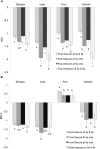Cross-Sectional and Longitudinal Associations between Household Food Security and Child Anthropometry at Ages 5 and 8 Years in Ethiopia, India, Peru, and Vietnam
- PMID: 26084361
- PMCID: PMC4516765
- DOI: 10.3945/jn.115.210229
Cross-Sectional and Longitudinal Associations between Household Food Security and Child Anthropometry at Ages 5 and 8 Years in Ethiopia, India, Peru, and Vietnam
Abstract
Background: Poor childhood nutritional status has lifetime effects and food insecurity is associated with dietary practices that can impair nutritional status.
Objectives: We assessed concurrent and subsequent associations between food insecurity and height-for-age z scores (HAZs) and body mass index-for-age z scores (BMI-Zs); evaluated associations with transitory and chronic food insecurity; and tested whether dietary diversity mediates associations between food insecurity and nutritional status.
Methods: We used data from the Young Lives younger cohort composed of children in Ethiopia (n = 1757), India (n = 1825), Peru (n = 1844), and Vietnam (n = 1828) recruited in 2002 (round 1) at ∼1 y old, with subsequent data collection at 5 y in 2006 (round 2) and 8 y in 2009 (round 3).
Results: Children from food-insecure households had significantly lower HAZs in all countries at 5 y (Ethiopia, -0.33; India, -0.53; Peru, -0.31; and Vietnam, -0.68 HAZ; all P < 0.001), although results were attenuated after controlling for potential confounders (Ethiopia, -0.21; India, -0.32; Peru, -0.14; and Vietnam, -0.27 HAZ; P < 0.01). Age 5 y food insecurity predicted the age 8 y HAZ, but did not add predictive power beyond HAZ at age 5 y in Ethiopia, India, or Peru. Age 5 y food insecurity predicted the age 8 y BMI-Z even after controlling for the 5 y BMI-Z, although associations were not significant after the inclusion of additional confounding variables (Ethiopia, P = 0.12; India, P = 0.29; Peru, P = 0.16; and Vietnam, P = 0.51). Chronically food-insecure households had significantly lower HAZs than households that were consistently food-secure, although BMI-Zs did not differ by chronic food-insecurity status. Dietary diversity mediated 18.8-30.5% of the association between food security and anthropometry in Vietnam, but mediated to a lesser degree (8.4-19.3%) in other countries.
Conclusions: In 4 countries, food insecurity at 5 y of age was associated with both HAZ and BMI-Z at age 8 y, although the association was attenuated after adjusting for other household factors and anthropometry at age 5 y, and remained significant only for the HAZ in Vietnam.
Keywords: child growth; dietary diversity; household food security; longitudinal cohort study; weight gain.
© 2015 American Society for Nutrition.
Conflict of interest statement
Author disclosures: DL Humphries, KA Dearden, BT Crookston, LC Fernald, AD Stein, T Woldehanna, ME Penny, and JR Behrman, no conflicts of interest.
Figures


Similar articles
-
The Relation Between Household Food Insecurity and Children's Height in Canada and the United States: A Scoping Review.Adv Nutr. 2019 Nov 1;10(6):1126-1137. doi: 10.1093/advances/nmz034. Adv Nutr. 2019. PMID: 31075160 Free PMC article.
-
Household food group expenditure patterns are associated with child anthropometry at ages 5, 8 and 12 years in Ethiopia, India, Peru and Vietnam.Econ Hum Biol. 2017 Aug;26:30-41. doi: 10.1016/j.ehb.2017.02.001. Epub 2017 Feb 14. Econ Hum Biol. 2017. PMID: 28222325 Free PMC article.
-
Are Household Expenditures on Food Groups Associated with Children's Future Heights in Ethiopia, India, Peru, and Vietnam?Int J Environ Res Public Health. 2020 Jul 1;17(13):4739. doi: 10.3390/ijerph17134739. Int J Environ Res Public Health. 2020. PMID: 32630270 Free PMC article.
-
Periods of child growth up to age 8 years in Ethiopia, India, Peru and Vietnam: key distal household and community factors.Soc Sci Med. 2013 Nov;97:278-87. doi: 10.1016/j.socscimed.2013.05.016. Epub 2013 May 28. Soc Sci Med. 2013. PMID: 23769211 Free PMC article.
-
Associations between food insecurity and child and parental physical, nutritional, psychosocial and economic well-being globally during the first 1000 days: A scoping review.Matern Child Nutr. 2024 Jan;20(1):e13574. doi: 10.1111/mcn.13574. Epub 2023 Oct 12. Matern Child Nutr. 2024. PMID: 37828823 Free PMC article.
Cited by
-
Climate-Driven Adaptation, Household Capital, and Nutritional Outcomes among Farmers in Eswatini.Int J Environ Res Public Health. 2019 Oct 23;16(21):4063. doi: 10.3390/ijerph16214063. Int J Environ Res Public Health. 2019. PMID: 31652699 Free PMC article.
-
Rural-urban differentials in child body mass index over time.BMC Pediatr. 2023 Aug 22;23(1):412. doi: 10.1186/s12887-023-04241-5. BMC Pediatr. 2023. PMID: 37608309 Free PMC article.
-
The Relation Between Household Food Insecurity and Children's Height in Canada and the United States: A Scoping Review.Adv Nutr. 2019 Nov 1;10(6):1126-1137. doi: 10.1093/advances/nmz034. Adv Nutr. 2019. PMID: 31075160 Free PMC article.
-
Household food insecurity is associated with asthma control in Peruvian children living in a resource-poor setting.J Asthma. 2020 Dec;57(12):1308-1315. doi: 10.1080/02770903.2019.1648506. Epub 2019 Aug 16. J Asthma. 2020. PMID: 31418600 Free PMC article.
-
Household food insecurity and early childhood development: Longitudinal evidence from Ghana.PLoS One. 2020 Apr 3;15(4):e0230965. doi: 10.1371/journal.pone.0230965. eCollection 2020. PLoS One. 2020. PMID: 32243485 Free PMC article.
References
-
- de Onis M, Blossner M, Borghi E. Prevalence and trends of stunting among pre-school children, 1990–2020. Public Health Nutr 2012;15:142–8. - PubMed
-
- UNICEF [Internet]. New York [updated 2014; cited 2014 Apr 5]. Available from: http://www.childinfo.org/malnutrition_nutritional_status.php.
-
- Adair LS, Fall CHD, Osmond C, Stein AD, Martorell R, Ramirez-Zea M, Sachdev HS, Dahly DL, Bas I, Norris SA, et al. . Associations of linear growth and relative weight gain during early life with adult health and human capital in countries of low and middle income: findings from five birth cohort studies. Lancet 2013;382:525–34. - PMC - PubMed
-
- Haas JD, Martinez EJ, Murdoch S, Conlisk E, Rivera JA, Martorell R. Nutritional supplementation during the preschool years and physical work capacity in adolescent and young adult Guatemalans. J Nutr 1995; 125(4, Suppl)1078S–89S. - PubMed

